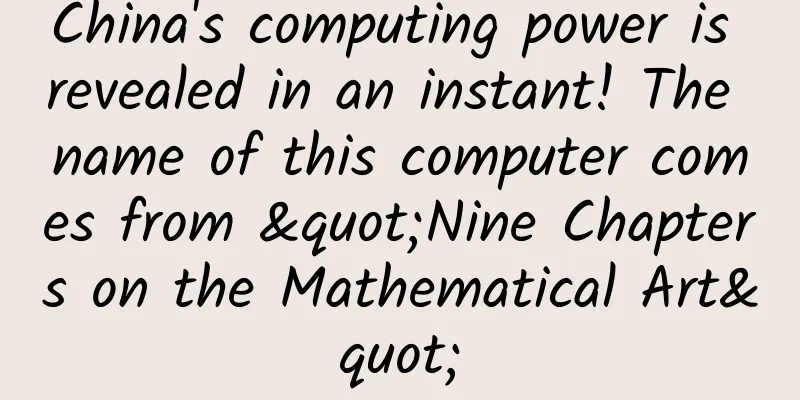China's computing power is revealed in an instant! The name of this computer comes from "Nine Chapters on the Mathematical Art"

|
If the nation stands on the basis of science and technology, the country will be strong. In 2023, my country's scientific and technological innovation ushered in many highlights: the domestically-made large aircraft C919 completed its first commercial passenger flight, the "Jiuzhang-3" set a new world record for optical quantum information technology, the first offshore carbon dioxide storage demonstration project was put into use, the space station entered a new stage of application and development, and the first domestically-made large cruise ship was named and delivered... At the beginning of 2024, the Digital Beijing Science Center specially planned the "New Scientific and Technological Breakthroughs" column to review the scientific and technological achievements made under the leadership of the Party in 2023. Computation is an ancient science. China's "Nine Chapters on the Mathematical Art" is the world's earliest book that systematically explains fractional operations and positive and negative number operations. Thousands of years have passed, and people's demand for calculations has long gone beyond ordinary addition, subtraction, multiplication and division. After the emergence of computers, the speed and amount of complex calculations have been exponentially improved, and the improvement of computing power is closely related to the development of modern social industry. The picture shows a real-life photo of optical quantum interference. The lower left is the input optical part, the lower right is the phase-locked optical path, and the upper part outputs 100 optical modes, which are connected to 100 superconducting single-photon detectors through low-loss single-mode optical fibers. Source: See watermark In October 2023, a research team composed of Pan Jianwei, Lu Chaoyang and others from the University of Science and Technology of China, in cooperation with the Shanghai Institute of Microsystem and Information Technology of the Chinese Academy of Sciences and the National Parallel Computer Engineering Technology Research Center, successfully built a 255-photon quantum computing prototype "Jiuzhang-3", once again breaking the world record for optical quantum information technology. The speed of processing Gaussian boson sampling is one million times faster than the previous generation "Jiuzhang-2". The most complex sample that can be calculated by "Jiuzhang-3" in 1 microsecond takes the world's fastest supercomputer "Frontier" about 20 billion years. What is a quantum computer? The concept of quantum computers was proposed by Feynman. In principle, they have super-fast parallel computing capabilities and can achieve exponential acceleration in the simulation of some problems with great social and economic value through specific quantum algorithms. Therefore, the development of quantum computers is one of the biggest challenges in the world's current scientific and technological frontiers. To understand how powerful quantum computers are, let's first understand some professional terms. Quantum In physics, a quantum is the smallest discrete unit of all physical properties. It usually refers to atoms or subatomic particles such as electrons, neutrinos, and photons. Quantum bit A quantum bit is the basic unit of information in quantum computing. The bits of traditional computers are binary and can only store 0 or 1, but a quantum bit can store a superposition of all possible states. Superposition Under normal conditions, we can only see the front or back of a coin, while the state of a quantum particle has been fluctuating, that is, including the positive, negative and alternating states of the coin until it is observed and measured, which is in a superposition state. Entanglement Entanglement is the ability of quantum particles to correlate their measurement results with each other. When quantum bits are entangled with each other, they form a system and influence each other. Increasing the number of quantum particles or entanglement allows computers to handle more complex problems. Quantum interference Quantum interference is the inherent behavior of quantum bits, which affects the possibility of their collapse mode due to superposition. Quantum computers need to minimize interference as much as possible to ensure the accuracy of the results. The picture shows a schematic diagram of light quantum interference. Source: See watermark Quantum computing exploits the unique behaviors of quantum mechanics (such as superposition, entanglement, and quantum interference) and applies them to computation. Why is Jiuzhang No. 3 so fast? Traditional computers are made up of electronic components, so their computing speed and capabilities have a "ceiling" in principle, but this does not exist in theory for quantum computers. The operation logic of quantum computing is different from that of traditional computers. Traditional computers perform logical operations based on binary. Each transistor is equivalent to a switch, and the state of the switch represents 0 and 1. Each operation can only process one bit of information. The larger the amount of information, the longer the calculation time. Quantum computers use quantum bits, which use the characteristics of quantum mechanics (superposition and entanglement) to realize operations. "Jiuzhang-3" optical quantum computer Source: Xinhua News Agency Professor Lu Chaoyang, the project leader, said: "An important feature of quantum computing is that as the number of controllable quantum particles increases, computing power grows exponentially. It's like walking through a maze. Traditional computers can only choose one path to try at a time. If they fail, they can only start over. But when a quantum computer walks through a maze, it's like 10 people trying different paths at the same time. They try all the possibilities in an instant and quickly find the right path." Schematic diagram of the experimental device Source: Jilin Daily "Jiuzhang-2" can manipulate 113 photons, and "Jiuzhang-3" can manipulate 255 photons, but the computing power of "Jiuzhang-3" is not increased by 2.26 times (255 divided by 113), but by 1 million times. Structurally, "Jiuzhang-3" is divided into four major parts: stimulated quantum light source, ultra-low loss quantum optical path, optical fiber ring with space-time demultiplexing, and superconducting nanowire single-photon detector. The biggest upgrade compared to "Jiuzhang-2" is the "optical fiber ring with space-time demultiplexing" technology. The "Jiuzhang-2" cannot analyze the specific number of photons, and the application of optical fiber rings can greatly improve the level of photon manipulation. At the same time, the stimulated quantum light source also has the lowest loss rate and the largest number of modes in the world. These innovations have increased the number and quality of photons, as well as the complexity of calculations. What will quantum computers be able to do in the future? Since quantum computers have super-fast parallel computing capabilities and super-large computing capacity in principle, scientists expect quantum computers to support larger and more complex computing requirements in high-tech fields such as code breaking, big data analysis, drug analysis, weather forecasting, and material analysis. Modern technology requires computing more and more complex data, and traditional computers may need to spend a lot of time and resources to get results, and may even be unable to meet computing needs, but there is still a long way to go to realize a practical general-purpose quantum computer. At present, international quantum computing research is accelerating, and quantum computing has become the focus of scientific research and strategic layout of countries around the world. Technology giants including IBM and Google are constantly increasing their investment, and governments and industries are also accelerating their investment in quantum computing research and development and policy support. The Jiuzhang team also expressed that they hope that this breakthrough will inspire more research on classical algorithm simulation in the scientific community, gradually solve various scientific and engineering challenges, and accelerate the realization of general-purpose quantum computers to promote economic and social development. Contents are compiled from: Guangming Daily, People's Daily, Xinhua News Agency New Media, Outlook News Weekly, Jilin Daily, Cover News |
<<: The young man who wrote to Einstein opened up a new direction in quantum mechanics
>>: Crossing the oceans and building a bridge of connection between China and Singapore
Recommend
The rise and fall of Chinese independent games
Not dominated by investors, developers are commit...
China Passenger Car Association: The wholesale sales volume of new energy passenger vehicles manufacturers in September 2022 is estimated to be 664,000 units, an increase of about 5% month-on-month
The China Passenger Car Association announced the...
"Online Loan Reduction Tutorial" Detailed operation method of charging 30,000 yuan outside
Course Contents: 1. Debt mentality management and...
What is mohair? Why is it so expensive?
Nothing is more suitable for autumn than a furry ...
Research finds: 80% of adults in the country are at risk of missing teeth! Avoid these 3 misunderstandings
"Losing teeth as you age" is a deeply r...
What is the "lung adenocarcinoma" that the famous magician suffers from? Here is the prevention manual →
Recently, the famous magician Liu Qian was interv...
Important results! Hualong Cave Man: A "checkpoint" in the transition from ancient humans to Homo sapiens in East Asia?
The Hualong Cave Site Academic Seminar was held i...
Chengdu Plain: Geographical Opportunities for Building a “Land of Abundance”
In 316 BC, the State of Qin began to annex the si...
The difference between theory and reality, what is the bottleneck in multi-core chip software development?
As competition in the mobile phone market intensi...
How to make data statistical tables for SEM? SEM data reports and problem analysis ideas!
Account data statistical analysis is the most imp...
What are those small, smelly yellow particles that come out of your mouth?
One minute with the doctor, the postures are cons...
Your cat is staring at you, does it actually want to eat you?
In the process of getting along with their cats, ...
Teach you how to do user operations in 3 minutes
In this era, whoever owns the users will be the k...
Toutiao’s passive traffic and customer acquisition method, a surefire way!
There is a saying in the Internet circle: "I...
Let's talk about how to achieve high performance with CQRS architecture
Introduction to CQRS Architecture You should all ...









